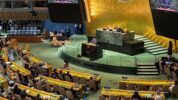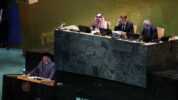Sulawesi Sea Boundaries Still Unsettled After Decades of Talks
The article below by I Made Andi Arsana. Lecturer in Geodetic Engineering at Gadjah Mada University, Researcher on the Geospatial Aspects of the Law of the Sea, and United Nations Conciliator representing Indonesia in Maritime and Law of the Sea Affairs)
Here’s his analysis:
Ambalat, Once Again
By I Made Andi Arsana
August 12, 2025
Two decades have passed, and the Ambalat issue has resurfaced. One of the sparks this time is the agreement between President Prabowo Subianto of Indonesia and Prime Minister Anwar Ibrahim of Malaysia to explore avenues for cooperation in the Ambalat waters.
It is important to understand that Indonesia and Malaysia have yet to agree on the maritime boundary in this area. Both countries are still in the process of defining an official and precise border.
Many assume that “Ambalat” refers to the entire stretch of sea east of Borneo (Kalimantan). This is inaccurate. Ambalat is not the official name of the sea. Internationally, the area is recognized as the Sulawesi Sea, as recorded in the official S-23 document issued by the International Hydrographic Organization (IHO).
Indonesia has claimed parts of the Sulawesi Sea since the 1960s by dividing it into oil and gas concession blocks. Specifically, in 1999 Indonesia created the Ambalat Block, and in 2004, the East Ambalat Block. These were designated for exploration and exploitation by international companies under Indonesian concession.
In reality, Ambalat represents only a small portion of Indonesia’s overall claim in the region. The official name of the sea remains the Sulawesi Sea.
Overlapping Claims.
The Sulawesi Sea is not under Indonesia’s sole jurisdiction; Malaysia also has sovereign rights there. Malaysia’s official claim was laid out in its 1979 New Map, which overlaps with Indonesia’s earlier claims. This map was protested not only by Indonesia but also by the Philippines. Nevertheless, both Indonesia and Malaysia have made unilateral claims in the Sulawesi Sea.
The Ambalat (1999) and East Ambalat (2004) blocks significantly overlap with Malaysia’s 1979 claim. In 2005, Malaysia issued its own oil and gas concession blocks, ND6 and ND7. Although they lie within Malaysia’s 1979 claim line, these blocks also overlap substantially with Indonesia’s Ambalat concessions—leading to what became known as the 2005 Ambalat dispute.
The competition arises because both countries are entitled to maritime zones in the area under the United Nations Convention on the Law of the Sea (UNCLOS) 1982. Coastal states have rights to maritime zones measured from their baselines.
Delimitation Process.
Maritime zones include the territorial sea (12 nautical miles), contiguous zone (24 nautical miles), exclusive economic zone (EEZ, 200 nautical miles), and the continental shelf, which can extend beyond 200 nautical miles.
For neighboring states like Indonesia and Malaysia, these zones naturally overlap. This makes delimitation—the process of drawing maritime boundaries—essential. Such delimitation requires geospatial and geodetic expertise to determine exact coordinates.
The process usually begins with bilateral negotiations. If talks fail, the matter may be taken to the International Court of Justice (ICJ) or the International Tribunal for the Law of the Sea (ITLOS). Before delimitation, each country typically presents its own proposed boundary.
UNCLOS sets out rules for delimitation: Article 15 for territorial seas, Article 74 for EEZs, and Article 83 for continental shelves. In the Ambalat and ND6/ND7 context, the continental shelf provisions of Article 83 apply. This article states that overlapping continental shelf claims must be resolved through an agreement that achieves an “equitable” result—not necessarily equidistance, a median line, or equal division.
The term “equitable” leaves wide room for interpretation, which explains why the delimitation process can be prolonged and complex. This is one of the main reasons the Indonesia–Malaysia maritime boundary in the Sulawesi Sea remains unresolved.
Joint Development.
If the boundary remains unsettled, what happens? Article 83 also encourages disputing states to make provisional arrangements for practical cooperation—such as joint development of natural resources—until a final boundary is agreed upon.
In other words, even without a fixed boundary, the two countries can collaborate in utilizing the disputed area. This appears to be the basis for the joint development proposal from President Prabowo and Prime Minister Anwar Ibrahim. However, such an arrangement must be approached with great caution and thorough study.
The Role of Sipadan and Ligitan
Located in the Sulawesi Sea, Sipadan and Ligitan islands were once disputed between Indonesia and Malaysia. Initially unclaimed under international law, both countries sought to establish sovereignty. The ICJ ultimately awarded them to Malaysia.
Some argue that ownership of these islands strengthens Malaysia’s position in the Sulawesi Sea. While there is some truth to this, Malaysia’s 1979 claim already included the islands, meaning their legal status does not fundamentally alter Malaysia’s stance.
Indonesia can argue convincingly that small islands like Sipadan and Ligitan should not significantly influence maritime boundary delimitation—especially if doing so would cause inequitable results.
In Summary
Indonesia and Malaysia have yet to agree on their maritime boundary in the Sulawesi Sea. Ambalat, East Ambalat, ND6, and ND7 are names unilaterally assigned by each country, but the official name remains the Sulawesi Sea.
The priority now is to finalize the maritime boundary. Past incidents should serve as motivation to accelerate the process. Joint management is legally possible but requires comprehensive consideration. Both countries have their own interests, yet as close neighbors sharing cultural roots, they must strive to maintain harmony. (Uki Ruknuddin)




























Tinggalkan Balasan